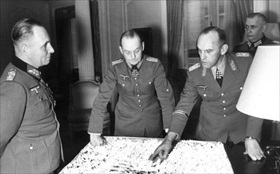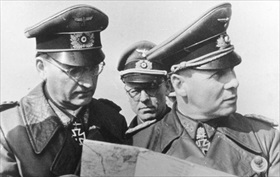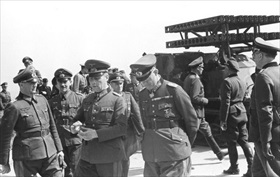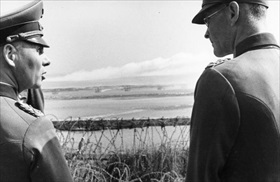D-DAY LAUNCH DATE RESET
Southwick House, Southeast England • June 4, 1944
Tomorrow, June 5, 1944, a Monday, was to have been an epic day—the day Allied forces invaded a 50‑mile/80‑km stretch of German-occupied beach on the French Normandy coast. The cross-Channel invasion of Northwestern France, codenamed Operation Overlord, had been pushed from May, when there had been roughly 18 days of near-perfect weather, to June to allow another month’s buildup of landing craft. Also at issue was the need for more minesweepers and warships for escorts and shore bombardment. But gloomy weather reports predicted unsuitable conditions for an amphibious landing in early June: launching landing craft from mother ships in strong winds and high seas would be nigh to impossible. Supporting Allied warships and aircraft would be hampered by low clouds and bad visibility.
Gen. Dwight D. Eisenhower, Supreme Commander Allied Expeditionary Forces, had tentatively selected June 5 as the start date (D‑Day) for the long-rehearsed assault on Festung Europa. But now he ordered Allied troop convoys already at sea to take shelter in bays and inlets on the south coast of England for the night. It seemed entirely possible that the make-or-break invasion, which had been more than a year in planning, would have to be delayed 2 weeks, and the shipborne troops, paratroopers, and glider-borne infantrymen ready to embark must return to their embarkation camps on lockdown. In their forced anchorages, 130,000 anxious men whiled away the hours playing dice and poker games, attended improvised church services, or kept to themselves.
At meetings late on this date, June 4, and early the next at Eisenhower’s forward command post near Portsmouth, Southeast England, Overlord’s 43‑year-old Scottish meteorologist Group Captain James Stagg of the Royal Air Force and his deputy U.S. Army Air Forces Col. Donald Yates cautiously predicted improvement for June 6 and part of June 7. The second day was crucial for protecting and resupplying the landing zones. British Gen. Bernard Law Montgomery, overall ground commander for the invasion, and Gen. Walter Bedell Smith, Eisenhower’s chief of staff, pressed Eisenhower to proceed. On the strength of Stagg and Yates’s pre-invasion weather forecast—the liberation of Western Europe quite literally hanging on the meteorological team’s best guess in an era without weather satellites, weather radars, and sophisticated computer forecasting—Eisenhower ordered the invasion to proceed 1 day later, on Tuesday, June 6.
Meanwhile the enemy took comfort from the existing poor weather conditions, which were worse over France than over the English Channel, and believed no Allied invasion was possible for several days. (Lucky for the Allies that German meteorologists could no longer harvest weather data from hidden stations in Greenland and ships in the North Atlantic that detected the brief interval of improved weather the Stagg-Yates team had predicted.) Brutal winds and torrents of rain grounded the few Luftwaffe recon aircraft still left in Northwestern France. Similarly, downpours, choppy Channel waters, and heavy swells deterred the Kriegsmarine from dispatching patrol boats from their safe moorings. Had the service done so on the night of June 5, it might have detected the initial Allied flotilla of over 290 minesweepers, followed by 1,200‑plus warships and 1,500 landing craft (figures vary greatly) heading toward the Normandy coast.
Some German troops stood down and many senior officers were away for the weekend. Even Marshal Erwin Rommel—the man entrusted with defending the French coast between Normandy and the Pas-de-Calais—sneaked in a few days of sanctioned leave to unwind and celebrate his wife’s 50th birthday back in Germany, while dozens of division, regimental, and battalion commanders were away from their posts conducting war games and a map exercise at Rennes in Brittany, 120 miles/193 km south of the Normandy beaches, just prior to the invasion. Their absence and those of large armored units and Luftwaffe squadrons close by meant that the 24‑hour period Rommel had given himself and the 100,000 men under his command to defeat the invaders had no chance of happening.
Erwin Rommel: Planning the Defense of Festung Europa, November 1943 to June 1944
 |  |
Left: Field Marshal Erwin Rommel (left, age 52), Field Marshal and Commander-in-Chief West (Oberfehlshaber West, OB West) Gerd von Rundstedt (center, nicknamed the “old Prussian”), and Lt. Gen. Bodo Zimmermann, Rundstedt’s operations officer at a staff conference in Paris, January 13, 1944. The 68‑year-old von Rundstedt, much too old to command in battle, had operational responsibilities for Wehrmacht forces in France, Belgium, and the Netherlands. Hitler sent Rommel to von Rundstedt in early November 1943 to prepare plans and make suggestions for the best ways of strengthening the coastal defenses of the Atlantic Wall. Rommel and many on his staff, over 200 officers and men from Army Group B, consisting of the Seventh and Fifteenth armies, trudged the length the Atlantic Wall from Pas-de-Calais (since 2016 part of Hauts-de-France), immediately opposite the English port city of Dover, to Normandy and Brittany and further south along the coast of the Bay of Biscay in early 1944 right through the end of May.
![]()
Right: Rommel (right) and his chief of staff Lt. Gen. Hans Speidel use a map to inspect potential invasion beaches at Pas-de-Calais, April 18, 1944. Von Rundstedt, like the German Military High Command (Oberkommando der Wehrmacht, OKW) and almost all German generals, believed that the Pas-de-Calais (French name of the Dover Strait), where the continent was closest to England (at one point just over 20 miles/32 km away) and the sea voyage short and air operations over the landing beaches simpler, was the most likely site for the anticipated Allied invasion. (The ill-fated August 1942 Dieppe Raid by 6,000 Canadian and British commandos [Operation Jubilee] had taken place there.) The Allies’ brilliant deception plans, which included false radio traffic and dummy vehicles, artillery, and aircraft from phantom field armies in Scotland and England, reinforced that belief in 1943 and much of 1944. Intuition led Hitler to think Normandy was where the invasion would come. The OKW, in a May 10 summary, appears to have agreed that the Schwerpunkt (principal target) was Normandy, followed by nearby Brittany, not Pas-de-Calais. Hitler hedged his bets, though: for more than a week after D‑Day, he needlessly tied down badly needed German divisions in the Calais area. By D+10 (June 16), it was too late to contain the Allied beachheads at Normandy.
 |  |
Left: Rommel at a special weapons display and demonstration of self-propelled artillery, tank destroyers, and other military hardware, including 12 155 mm cannon, at the Riva Bella emplacement next to the Orne estuary, May 30, 1944, a week before the cross-Channel invasion. Riva Bella, a village just west of May 30, 1944, a week before the cross-Channel invasion. Riva Bella, a village just west of Ouistreham, was about 10 miles/16 km north of Caen in the area that would become Sword Beach, the easternmost D‑Day landing site. In the distance behind Rommel (hands folded in front) is a jury-rigged French half-track transporter of the newly introduced 80 mm multi-barrel rocket launcher. The “Screaming Meemies,” named for the eerie screech the electronically fired 80 mm/3.15 in. rockets made in flight, were the most fearsome weapon the Allies faced during the Normandy Campaign. The whooshing projectiles had a range exceeding 7,500 yards/6,858 meters. Twelve days earlier Rommel had given Major Alfred Becker and the enterprising group responsible for manufacturing the unique mobile rocket launchers a production order for a thousand to be delivered in short order. German defenders at Riva Bella and Ouistreham were expelled on D‑Day by a mixed force of French and British commandos.
![]()
Right: Rommel and Gen. Erich Marcks, Seventh Army, 84th Infantry Corps observe artillery shells shot from coastal batteries falling into the sea at Riva Bella, May 9, 1944. German coastal batteries ranged in size from 75 mm to massive 380 mm guns. Less than a month later, on June 3, Marcks groused to Rommel that the defensive construction program in his zone in Normandy (it turned out to be the D‑Day invasion beaches) was only half done. For example, high-tide obstacles were mostly in place but low-tide obstacles were practically nonexistent; ominously, German intelligence reported that the Allies had recently practiced low-tide landings. The previous summer Rommel, in his role as a “military advisor” to Adolf Hitler at the Fuehrer’s East Prussian headquarters, argued for withdrawing all 2.6 million German soldiers on Germany’s Eastern Front behind a “suitable prepared line” of fortified positions and avoiding any new offensives against the Soviet Union “for the next few years.” Less worried about surrendering the strategic initiative to the Red Army for several years was the thought that his country could wind up fighting on 2 fronts: “Our main effort must be directed toward beating off any attempt of the Western Allies to create a second front . . . If we can once make their efforts fail,” he explained to his former chief of staff, Lt. Gen. Fritz Bayerlein, “then things will be brighter for us” when Germany can again concentrate on a single front. Rommel was keenly aware from studying previous Allied amphibious operations that once the enemy had secured a beachhead, it was impossible for the defenders to repel him. “The war will be won or lost on the beaches,” Rommel told anyone with 2 ears to hear.
German Newsreel Showing Field Marshal Erwin Rommel Inspecting Atlantic Wall Defenses, January 1944 (in German)
![]()

 History buffs, there is good news! The Daily Chronicles of World War II is now available as an ebook for $4.99 on Amazon.com. Containing a year’s worth of dated entries from this website, the ebook brings the story of this tumultuous era to life in a compelling, authoritative, and succinct manner. Featuring inventive navigation aids, the ebook enables readers to instantly move forward or backward by month and date to different dated entries. Simple and elegant! Click
History buffs, there is good news! The Daily Chronicles of World War II is now available as an ebook for $4.99 on Amazon.com. Containing a year’s worth of dated entries from this website, the ebook brings the story of this tumultuous era to life in a compelling, authoritative, and succinct manner. Featuring inventive navigation aids, the ebook enables readers to instantly move forward or backward by month and date to different dated entries. Simple and elegant! Click 











